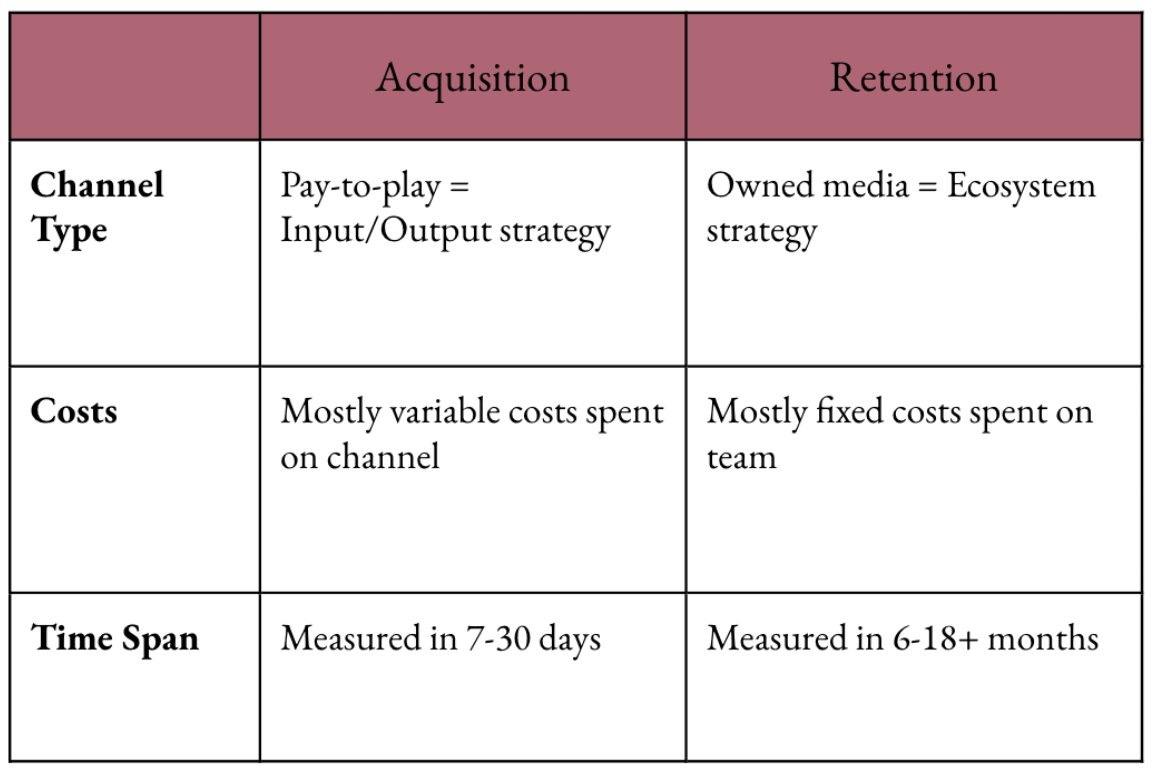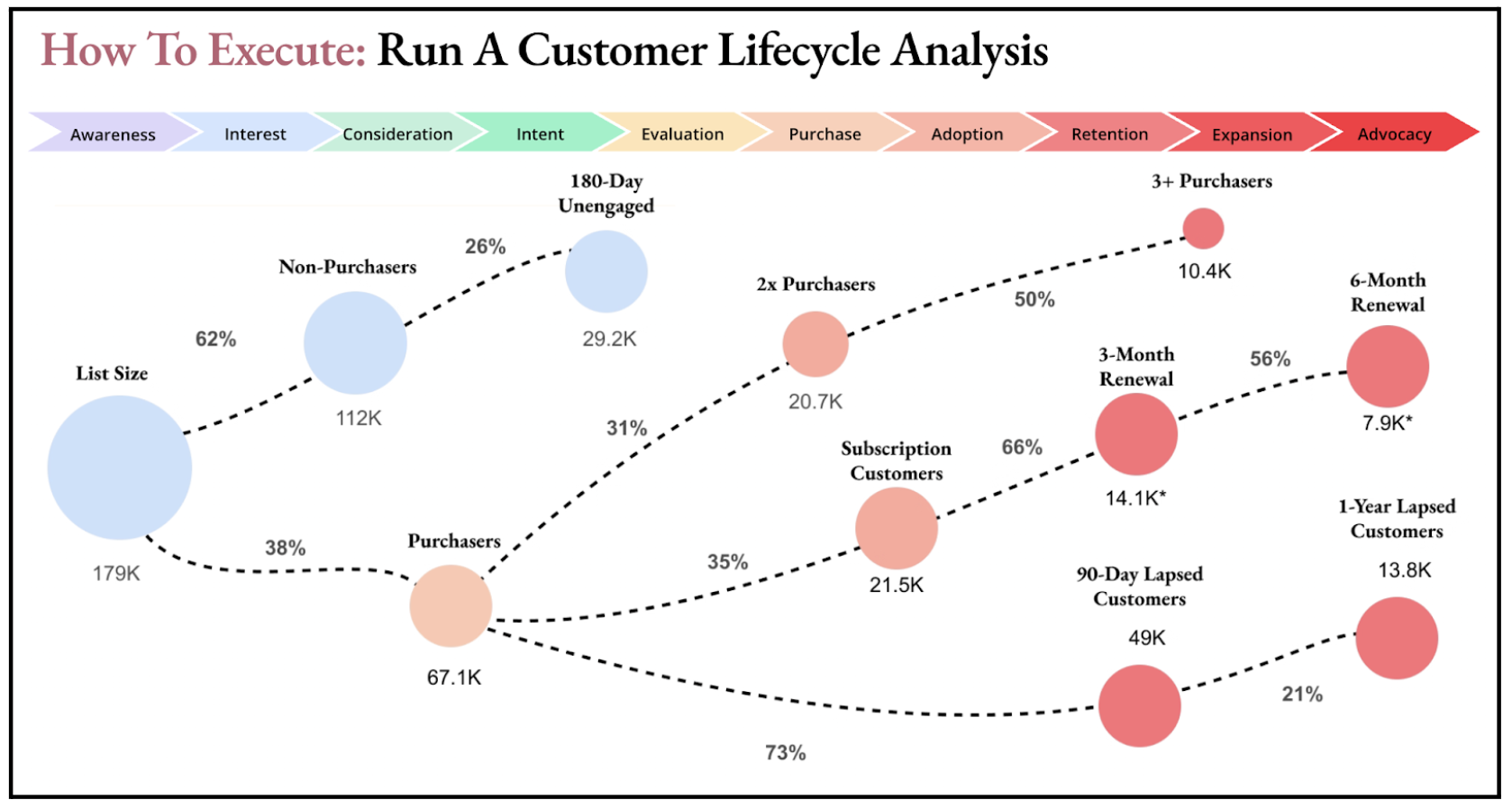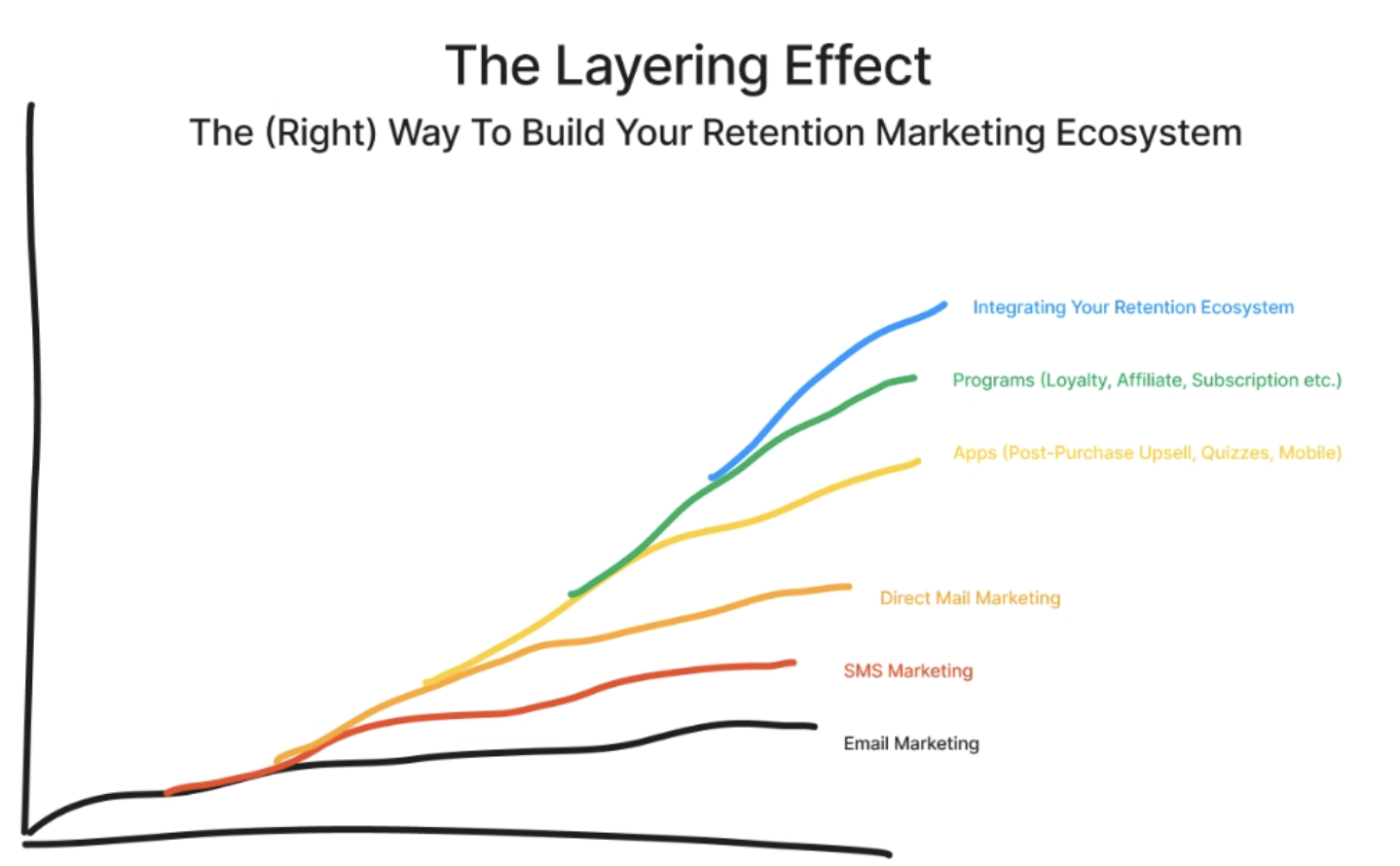Lessons from Building $300 Million In DTC Retention Ecosystems
Stop wasting money on half-hearted retention tactic, and use this 3-step approach to build a cohesive ecosystem that can take your DTC brand to 8-figures and beyond.
-1.png)
One of the biggest challenges ecomm brands face when scaling from seven to eight- or nine-figures is the transition from an “acquisition-first” to an “acquisition + retention” approach to growth.
Acquisition & retention marketing are very different.
Where acquisition is primarily about finding product-market fit and “cracking” different ad channels, retention strategies are focused on increasing customer lifetime value (LTV) by getting people to:
- Buy faster
- Buy more (increased AOV)
- Buy more frequently (repeat purchases)
- Take more action (engagement with brand, word of mouth, etc.)
They require a completely different approach:

Founders often don’t realize this difference, and approach their retention marketing the same as their acquisition strategies. As a result, their retention efforts are reactive and low-yield because they…
- Focus on optimizing individual retention channels instead of building an ecosystem
- Measure short-term ROI on retention efforts & pull the plug too early
- Underspend on time & resources which leads to underwhelming results
Getting retention marketing right & building a Retention Ecosystem is the key to building a scalable, sustainable, profitable company.
Hampton member Jess Chan is the founder of Longplay, a retention marketing agency that’s driven more than $300 million for clients over the last few years by helping them build high-performance retention ecosystems.
She sat down with us to discuss her team’s playbook, and the three key steps to developing a robust retention strategy.
1. Shifting to Customer-Centric
The big difference between acquisition and retention is that when it comes to your retention efforts, all of your decisions start and end with this graphic:

This is the marketing funnel. The goal is to get more customers moving through each stage of the funnel, faster. Retention marketing begins the moment someone lands on your site, extends through their first purchase to (hopefully) repeat purchase, expansion, and on to the day they recommend you to others, creating word-of-mouth interest.
In acquisition, each channel stands on its own. You focus on them in isolation, iterating quickly to try and drive ROAS.
But retention looks at a much broader picture, zooming out to consider the entire customer’s lifecycle through each stage of the marketing funnel:

The reason this mindset change is so critical is that it helps you understand how all of the channels, tools & programs work together to move customers through each stage of the customer journey.
With so many options on where to focus, it’s easy to waste money on experiments that have no chance of moving the needle. But making this shift to the broader view helps you identify exactly where to deploy your resources. Here’s how…
2. Focus On Hot Spots
After you map your customer lifecycle, the next step is to audit it. Review your data to see how people are currently moving through your marketing funnel, and more importantly, where you’re losing them.

These “hot spots” represent some of your highest-ROI opportunities to experiment with retention campaigns.
Benchmarks on these vary from business to business, and it’s important to think of them in terms of “Goldilocks” figures – not too high or too low.
It’s tempting to look at something like the percent of non-purchasers on your email list and believe that lower is automatically better. But the reality is if this figure is too low, it likely means you’re struggling to scale acquisition and win emails.
A similar case for something like repeat purchasers – if it’s too low, you have work to do. But too high, and that’s an indication that you’re not scaling quickly enough.
Some (general, product-agnostic) healthy ranges on common hot spots, according to Jess…

Once you know where you’re losing people, start by building and refining the main retention email & SMS flows that correlate with that segment of the customer journey.
Below is a comprehensive list. You don’t need all of these. Instead, you should think of this as an “ideal” example. Your goal is to use this alongside your data to pick the highest-priority one, then:
- Build the proper flow
- A/B test it for 3-6 months to optimize the $/recipient
- Run your analysis again to see if you should continue iterating or move to another hot spot
For each test, it’s important to decide what success should look like in how it moves the needle for your business. For example, an Abandoned Cart Flow should get more customers from Evaluation to Purchase. Without defining success clearly, you’ll never know when it’s time to move on to another priority.
-1.png?width=725&height=408&name=Blog%20Featured%20Image%20(37)-1.png)
For way more detail on how to build the most common ones, check out Longplay's full guide to DTC flows.
3. Continue Building The Ecosystem
Email and SMS are a solid starting point for 99.9% of ecomm brands. But over time you’ll continue adding to your retention ecosystem by layering on additional…
- Channels: These are ways to reach customers. Direct Mail has been seeing a lot of success, and Jess says it worth testing for most DTC brands these days
- Tools: Apps and Shopify plugins that target a specific part of the customer journey (E.g., post-purchase up-sell, re-order, cross-sell, and quizzes)
- Programs: Designed to deepen your relationship with customers (E.g., loyalty programs)
At each stage, you want to be strategic. Don’t just bolt on a loyalty program because you heard that’s working for a lot of brands these days.
Instead, return to your lifecycle, look for the hot spots, pick a channel that will help you move people to the next stage in their journey, then design a small test with clear success metrics.
Run that test for ~90 days, and evaluate ROI. If successful, develop a plan to integrate the retention strategy fully into your ecosystem along with all the other channels, tools, and programs your business has.

In this way, you add depth to your retention ecosystem. And because things are fully integrated, rather than operating in isolation, the effect is more like 1 + 1 = 10
Personally, I find being the CEO of a startup to be downright exhilarating. But, as I'm sure you well know, it can also be a bit lonely and stressful at times, too.
Because, let's be honest, if you're the kind of person with the guts to actually launch and run a startup, then you can bet everyone will always be asking you a thousand questions, expecting you to have all the right answers -- all the time.
And that's okay! Navigating this kind of pressure is the job.
But what about all the difficult questions that you have as you reach each new level of growth and success? For tax questions, you have an accountant. For legal, your attorney. And for tech. your dev team.
This is where Hampton comes in.
Hampton's a private and highly vetted network for high-growth founders and CEOs.





